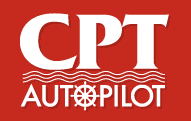Operation Questions
- Where can I get a copy of the manual?
- Can I use the CPT to tack my sailboat?
- I’ve heard that autopilots don’t work well in a cockpit, is that true?
- I've heard that wheel-mounted autopilots are not suitable for blue-water ocean passages, will the CPT work for such a passage?
- I've heard that with wheel-mounted autopilots, the belt slips or the gears or motor burns out in rough conditions. Is the CPT any different?
- What is the benefit of the CPT if I only intend to use my autopilot for motoring in mild conditions?
Where can I get a copy of the manual?
Current Owner’s Manuals:
Documentation for older models: Owner’s Manual For Dial Autopilots
Can I use the CPT to tack my sailboat?
Yes, when you are ready to tack, hold the 1° and 10° buttons down for 5 seconds. Release the buttons to initiate the tack. Tacking will change the boat heading by 100°. The default 100° tack angle can be changed to any angle between 60° and 120° depending on the needs of the vessel.
I’ve heard that autopilots don’t work well in a cockpit, is that true?
The CPT uses an electronic heading sensor capable of operating at up to 45 degrees of tilt. The CPT sensor responds quickly and works reliably in the cockpit.
I've heard that wheel-mounted autopilots are not suitable for blue-water ocean passages, will the CPT work for such a passage?
Yes, the CPT has been used for many such passages. It is rated for immersion and will stand up to wet cockpit conditions. Many vessels use the CPT along with a windvane, and vessels with a below decks pilot often use it when sailing due to its low electrical current draw. A self steering back-up is always recommended for long distance cruising. See Testimonials.
I've heard that with wheel-mounted autopilots, the belt slips or the gears or motor burns out in rough conditions. Is the CPT any different?
The CPT is different and can handle conditions other wheel pilots cannot.
The strength of the CPT comes from the size of its motor and gearing. The robust motor of the CPT produces a higher torque and rpm at the wheel, allowing it to respond faster with more torque to spare than other wheel pilots. The CPT develops 86 ft-lbs of torque and up to 7 rpm at the wheel. Many CPTs over 20 years old are still steering boats with the original motor, and can still be serviced and repaired.
The CPT uses a toothed wheel pulley and drive gear that eliminates the need for high belt tension. With too much weather-helm or wheel loads the belt may eventually begin to jump in its cogs, which indicates it is time to reef & balance the boat to reduce the loads at the wheel.
What is the benefit of the CPT if I only intend to use my autopilot for motoring in mild conditions?
The CPT is rated for immersion and built to last. After years of use it can still be serviced and repaired if needed, and you won’t have to throw it away for the next latest model. You may not intend to use the autopilot when sea and wind conditions get rough; but when you are short handed, sleep deprived, and unexpected emergencies come up, why not have an autopilot you can depend on?
Go to the top of this page